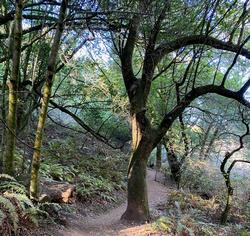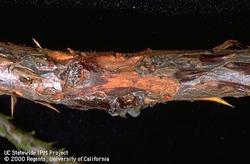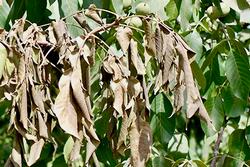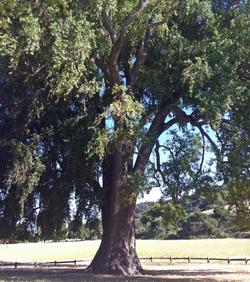Bots Breaking Bad - Bay Laurel Trees Are Under Attack
-
Barbara Robertson
-
For years, a sleeper cell in our native Bay Laurel trees, a pathogen named botryosphaeria, has been lying low, waiting to attack when the tree’s defenses are down. That time is now.
 The optimum environment for Bay Laurel trees has morning sun and water much of the year. Photo: Barbara Robertson
The optimum environment for Bay Laurel trees has morning sun and water much of the year. Photo: Barbara RobertsonBay Laurels have had a free run for many years. They’ve overpopulated optimal sites that have water much of the year and have expanded into drier grasslands and shrub lands. A normal cycle of fires might have culled fire-sensitive saplings, but we have prevented fire from taking a routine role in managing the environment. Thus after establishing themselves during wet years, Bay Laurels have survived earlier droughts and grown. Now, they’re large trees with a great need for water. Meanwhile, this year’s drought has gone from dry to scary dry, from extreme to exceptional. Cue Botryosphaeria.
Botryosphaeria is a genus of fungi. They’re opportunistic stress-associated pathogens that can cause cankers and dieback on many woody plants, and they are endophytes. That is, they live within a host, often without causing damage.
“We call it ‘Bot’ for short,” says Steven Swain, environmental horticulture advisor for Marin and Sonoma. “Bot infects young plants and lives with the plant forever. Bots don’t cause anything bad unless a plant is stressed. They just wait to pounce. It infects many species and has a wide variety of hosts because something is always being stressed.”
Drought-stressed woody plants are typical hosts for Botryosphaeria. But, so are plants grown away from their native habitat – such as a Bay Laurel in grasslands or a giant Sequoia planted in a well-watered, warm lawn. Bot attacks many species of woody plants when they’re stressed including this Giant Sequoia. Photo: UC Regents
Bot attacks many species of woody plants when they’re stressed including this Giant Sequoia. Photo: UC Regents“Bot doesn’t care what stresses a plant,” Swain says. “When a plant is stressed, Bot attacks. When you see branches at the tops of Redwoods in Novato dying back, it’s probably from Bots. Shaded branches of Madrones and Manzanitas get it because they want lots of light.”
But Bot in the Bay Laurels is new.
“I haven’t often seen it on Bay Laurel trees in the past,” Swain says.
Swain says that if you see a Bay Laurel with dead branch tips it’s possibly the target of a Bot attack, not simply drought stressed. Bot is newly discovered in Bay Laurels. Look for dying leaves at branch tips as in this walnut tree. Photo: Themis J. Michailides, courtesy UC IPM
Bot is newly discovered in Bay Laurels. Look for dying leaves at branch tips as in this walnut tree. Photo: Themis J. Michailides, courtesy UC IPM“If a Bay Laurel is drought stressed, you’ll see little leaves alive at the tips and older leaves drying and dropping,” he says. “If the tree is infected with Bot, you’ll see a branch dying back from the tip and usually a bigger branch sprouting out below. But because these symptoms can come from lots of things, we take samples.”
Swain uses samples to determine whether a tree is suffering from Bot or something else. Bot is a normal pathogen; it won’t wipe out an entire species. If something else is attacking the tree, it might need to be quarantined.
“We don’t worry about Bot spreading or not spreading,” Swain says. “Bot is already everywhere. Bot is a generalist.” Bay Laurel trees have expanded their range into grasslands & other suboptimal areas making them susceptible to Botryosphaeria attack. Photo: Schmiebel
Bay Laurel trees have expanded their range into grasslands & other suboptimal areas making them susceptible to Botryosphaeria attack. Photo: SchmiebelThe fungi spores spread primarily in splashing water during rain. As Bot infects tissues, it forms small, black-colored fruiting structures (pycnidia) that may erupt through the bark. Infected Bay Laurels don’t always have these cankers, but if you were to cut into the wood, you’d see a dark black, wedge-shaped discoloration of the tissue. Fungicides can treat Bot, but using a fungicide might not be the best idea. Instead, remove any dead and dry branches as part of your regular fire-smart maintenance, and concentrate on strengthening the plant’s defenses.
“When you have widely distributed fungi that prey on stressed plants, generally the best strategy is to focus on plant health,” Swain says. “Watering would be best. The focus isn’t on getting the plant to be lush. Don’t kill it with kindness by creating a warm moist soil. Use a soaker hose to get water 10 inches down and then wait to water again until it’s dry 10 inches down. Give it only enough water to keep the stress level to a dull roar.”
For more information visit https://marinmg.ucanr.edu.




